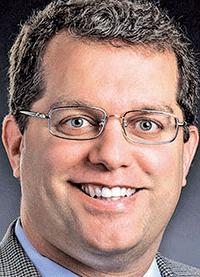As automakers race to improve fuel economy, the industry is entering an era that Terrence Hahn dubs "the golden age of turbochargers."

As CEO of Honeywell Transportation Systems, which calls itself the world's largest turbo producer, Hahn's chief challenge in the short run is to keep up with demand.
But in the long run, he plans to exploit the auto industry's migration to 48-volt electrical systems by developing electric turbochargers, a technology that Honeywell produces for Ferrari's Formula One race cars.
Hahn, 49, described these and other initiatives in an April 11 interview with Staff Correspondent David Sedgwick.
Q: Honeywell has predicted that 47 percent of vehicles produced worldwide will be turbocharged by 2020, correct?
A: We have.
What is the penetration rate?
Today, 37 percent of new passenger vehicles have turbos. Going from 37 percent of all vehicles today to half by the end of the decade will be a significant jump.
Where will the biggest increase occur?
We see the biggest growth occurring in China and the United States. That's because European penetration is already quite significant. In Europe, it's at 69 percent now, and we see that going to 73 percent by 2020.
As we look at China today, it's at 28 percent, and it will go up to 47 percent by 2020. In the United States, it's 23 percent and it will go up to 39 percent.
Those are rapid ramp-ups. In addition to that, the transition to turbocharged engines is taking place in other engine-producing countries like Japan, Korea, Brazil and India. It's a global phenomenon.
Does Honeywell expect the greatest growth rate to occur with three-cylinder engines?
We do. The downsizing trend to three- and four-cylinder engines continues. We have helped customers to optimize both of those engines.
Aren't most four-cylinder engines turbocharged? Isn't that a mature market?
I think it's too early to call it mature. There are still customers who have to downsize their powertrains. So we're still in the steep part of the growth curve.
How much revenue will Honeywell Transportation Systems generate from turbo sales?
We don't give guidance on that anymore. But the majority of our business is turbochargers. Our "win rate" on contracts is above 40 percent of the business that we bid on.
Honeywell has developed an electric charger for the turbocharger -- dubbed an e-charger -- that is optimized for 48-volt electrical systems. It can spool up a turbocharger's blades in a fraction of a second, correct?
We're excited about the technology. We've established an electric products group, and it's focused on hybrid vehicles and new technologies.
How does the e-charger complement a conventional turbocharger?
The element that you are looking for is transient response, or turbo lag. Our target keeps getting tighter and tighter, down to a tenth of a second. If you already have a 48-volt system in the vehicle, then the e-charger gives you an opportunity to achieve quicker acceleration, yet you still get the fuel efficiency of a mechanical turbocharger. We think there will be a lot of value.
So Honeywell's e-charger minimizes turbo lag?
Yes. The other benefit is that you can optimize a hybrid powertrain. The data we've seen shows that a hybrid vehicle beats a pure electric car on performance and economics. The idea is to optimize the hybrid by further downsizing its internal combustion engine. So you'll get the range that every driver wants, and you'll have the fuel economy benefits of a hybrid. It's the best of both worlds.
When will Honeywell produce an e-charger?
We have some pilot projects with customers and we'll see a start of production before the end of this decade. It will be in 2017, 2018 or 2019, based on our customers' decisions. We don't announce those projects; we let our customers announce them.
What else is Honeywell cooking up?
The next step is a full electric turbocharger, which uses electricity from a battery to increase airflow into the engine. During periods when the vehicle is not accelerating, you can put some of that energy back into the generator to recharge the battery. It allows people to get acceleration when they need it, and it provides better fuel efficiency, too. Ferrari uses our technology in Formula One racing.
So the e-turbo has two roles. Does Honeywell intend it primarily for hybrid vehicles?
We do. Once you've put a 48-volt electrical system on the vehicle, there will be a demand to further optimize it. So we are harnessing the mechanical energy of a turbocharger, which we've done for decades, and we also are generating electrical energy and putting it back into the battery.
Does Honeywell expect a high percentage of plug-in hybrids to get e-boosters or e-turbos?
We do. You need to get better fuel efficiency. We're hearing this from customers around the globe. They expect to downsize engines on hybrid platforms.
Will we see a big increase in turbo hybrids over the next five years?
It's a matter of the automakers' spending preferences. We've got significant turbo penetration whether or not the vehicles are hybrids. That's why we refer to this period as the golden age of turbochargers.
We do see a transition to hybrids coming. I don't want to predict the day, the hour or the time, but we hear that everybody is going in that direction.
Honeywell sees e-chargers, e-turbos on the horizon
